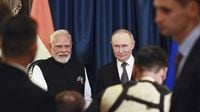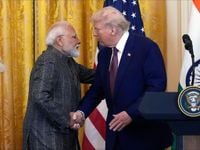In a week that saw global powerhouses gather in Tianjin, China, the diplomatic chessboard was on full display as Indian Prime Minister Narendra Modi, Russian President Vladimir Putin, and Chinese President Xi Jinping clasped hands and exchanged smiles at the Shanghai Cooperation Organization (SCO) summit. Their public show of unity came at a time when India’s relationship with the United States is facing its most severe test in years—thanks in large part to a bitter trade dispute and India’s continued purchases of Russian oil.
On Monday, September 1, 2025, President Donald Trump doubled down on his hardline approach to India, defending the steep tariffs his administration imposed as punishment for what he described as a “totally one sided disaster” of a trade relationship. In a pointed post on his Truth Social platform, Trump wrote, “What few people understand is that we do very little business with India, but they do a tremendous amount of business with us. In other words, they sell us massive amounts of goods, their biggest ‘client,’ but we sell them very little – Until now a totally one sided relationship, and it has been for many decades.” He continued, “The reason is that India has charged us, until now, such high Tariffs, the most of any country, that our businesses are unable to sell into India. It has been a totally one sided disaster!”
The numbers back up Trump’s frustration. On August 27, the U.S. import tax on Indian goods jumped to a staggering 50 percent, following an additional 25 percent tariff imposed by the Trump administration as a penalty for India’s ongoing purchases of Russian oil. Before this, India already faced a 25 percent reciprocal tariff on its exports to the U.S. The new duties, among the highest announced by the Trump administration, have the potential to slash India’s exports to the U.S. by over 40 percent annually—amounting to nearly $37 billion, according to trade analysts cited by UBN News.
Trump’s ire wasn’t reserved for trade alone. He criticized India for buying “most of its oil and military products from Russia, very little from the U.S.” and accused New Delhi of indirectly funding Russia’s war in Ukraine. White House Trade Adviser Peter Navarro took it a step further, calling India’s Russian oil purchases “Modi’s War,” and charging India with helping to sustain Moscow’s war effort through its energy imports.
But New Delhi has pushed back, defending its energy strategy as a financial necessity for a country of 1.4 billion people. Indian refineries are preparing to increase their Russian oil intake by 10–20 percent in September, equating to an additional 150,000–300,000 barrels daily. In the first 20 days of August, India imported 1.5 million barrels of Russian oil per day, matching July’s figures but slightly below the January–June average of 1.6 million barrels daily. Since the full-scale Russian invasion of Ukraine, India has saved approximately $17 billion by importing cheaper Russian oil, according to Indian Oil and Natural Gas Corporation statements reported by UBN News. Russia now supplies roughly 40 percent of India’s oil needs, making India the largest buyer of Russian oil transported by sea.
Despite the mounting pressure from Washington, India’s Commerce and Industry Minister Piyush Goyal has made it clear that New Delhi will not be bullied. “We will neither bow down nor ever appear weak” in our economic relationships, Goyal said, as reported by Al Jazeera. Indian officials have also noted that New Delhi has offered to reduce tariffs on U.S. goods to zero, though Trump dismissed the gesture as too little, too late: “They have now offered to cut their Tariffs to nothing, but it’s getting late. They should have done so years ago. Just some simple facts for people to ponder!!!”
As the tariff standoff raged, Modi was busy on the sidelines of the SCO summit, deepening India’s ties with Russia and China. On Sunday, August 31, he met with Xi Jinping, with both leaders pledging to resolve their border differences and bolster cooperation. “The dragon and the elephant can dance together,” Xi said, according to China’s state broadcaster CCTV. Modi, for his part, stressed “the importance of peace and tranquillity on the border areas for continued development of bilateral relations.”
The following day, Modi’s meeting with Putin was marked by warmth and symbolism. The two leaders held talks focused on regional stability, bilateral trade, and energy cooperation. In his opening remarks, Modi called the partnership with Moscow “special and privileged.” Putin, addressing Modi as a “dear friend,” said, “Russia and India have maintained special relations for decades. Friendly, trusting. This is the foundation for the development of our relations in the future.” According to NPR, the pair spoke one-on-one for nearly an hour in Putin’s Russian-made limousine before the formal meeting. Modi later posted to X, “We discussed ways to deepen bilateral cooperation in all areas, including trade, fertilizers, space, security, and culture. We exchanged views on regional and global developments, including the peaceful settlement of the conflict in Ukraine. Our Special and Privileged Strategic Partnership remains a key pillar of regional and global stability.”
Putin’s foreign affairs adviser, Yuri Ushakov, announced that the Russian president plans to travel to India in December for the 23rd India-Russia annual summit, signaling that the relationship is set to deepen further. Trade between the two countries has surged, reaching a record $68.7 billion in the 2024–25 financial year, with imports from Russia totaling around $64 billion and Indian exports about $5 billion. The two nations aspire to boost trade to $100 billion by 2030, according to Indian government data cited by NPR.
Analysts say that the Trump administration’s aggressive tariff strategy and confrontational rhetoric may have had the unintended consequence of pushing India closer to both Russia and China. “While India-China reengagements started much before Trump, his policies are accelerating a process whereby India seems to be working much more closely with China and Russia to push back against economic unilateralism it is witnessing from the U.S.,” Harsh Pant of the Observer Research Foundation told NPR.
For now, India appears determined to chart its own course, leveraging its relationships with both the West and the East. International affairs expert Sreeram Sundar Chaulia summed up New Delhi’s approach: “India prized its old and reliable strategic partners and has sufficient strategic autonomy in its foreign policy to maintain and strengthen its multi-dimensional partnership.” At the same time, Indian officials hope the current turbulence with Washington is temporary, envisioning a future where India can “return happily to having the Russian cake and eating the American pie as part of its multi-alignment strategy.”
As the world watches the evolving power dynamics, one thing is clear: India is no longer content to play second fiddle in global affairs. Whether the U.S. and India can find common ground remains to be seen, but for now, New Delhi’s pivot toward Moscow and Beijing is reshaping the landscape of international alliances.

